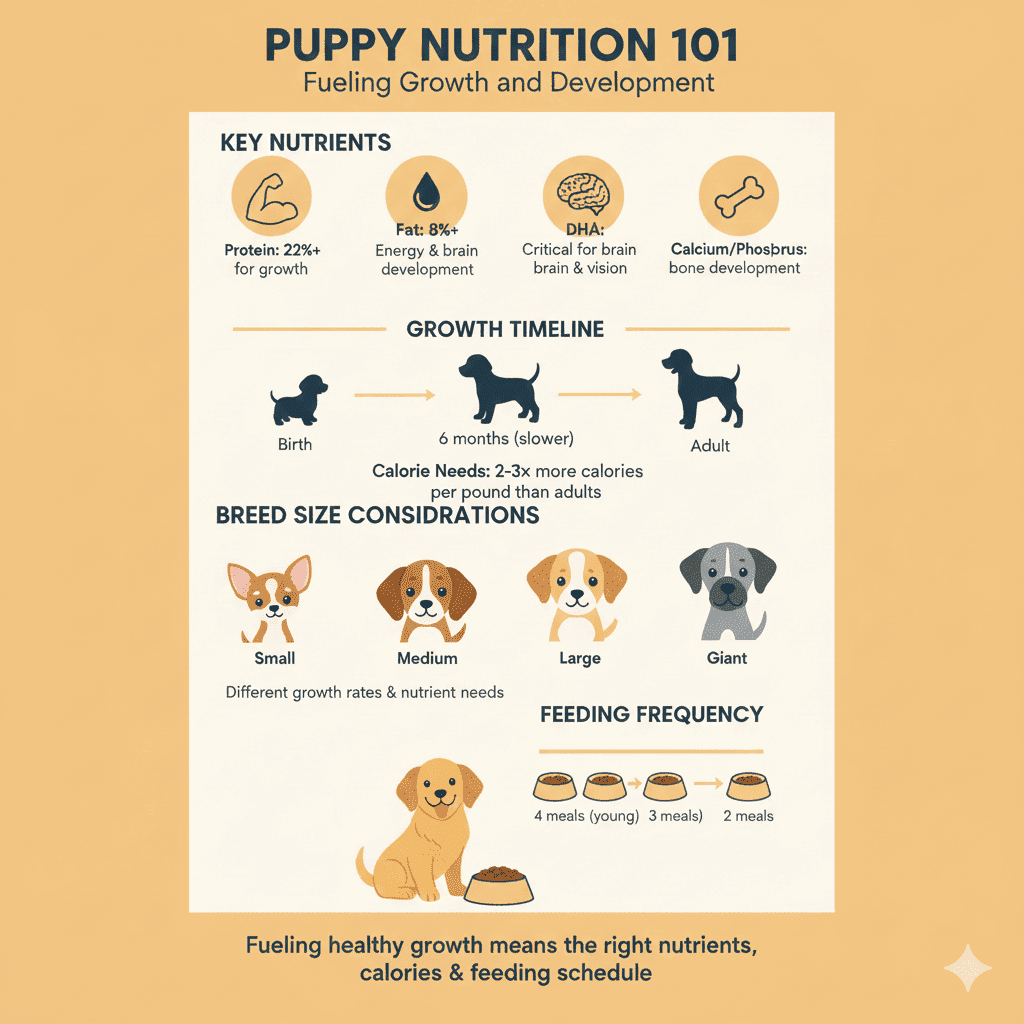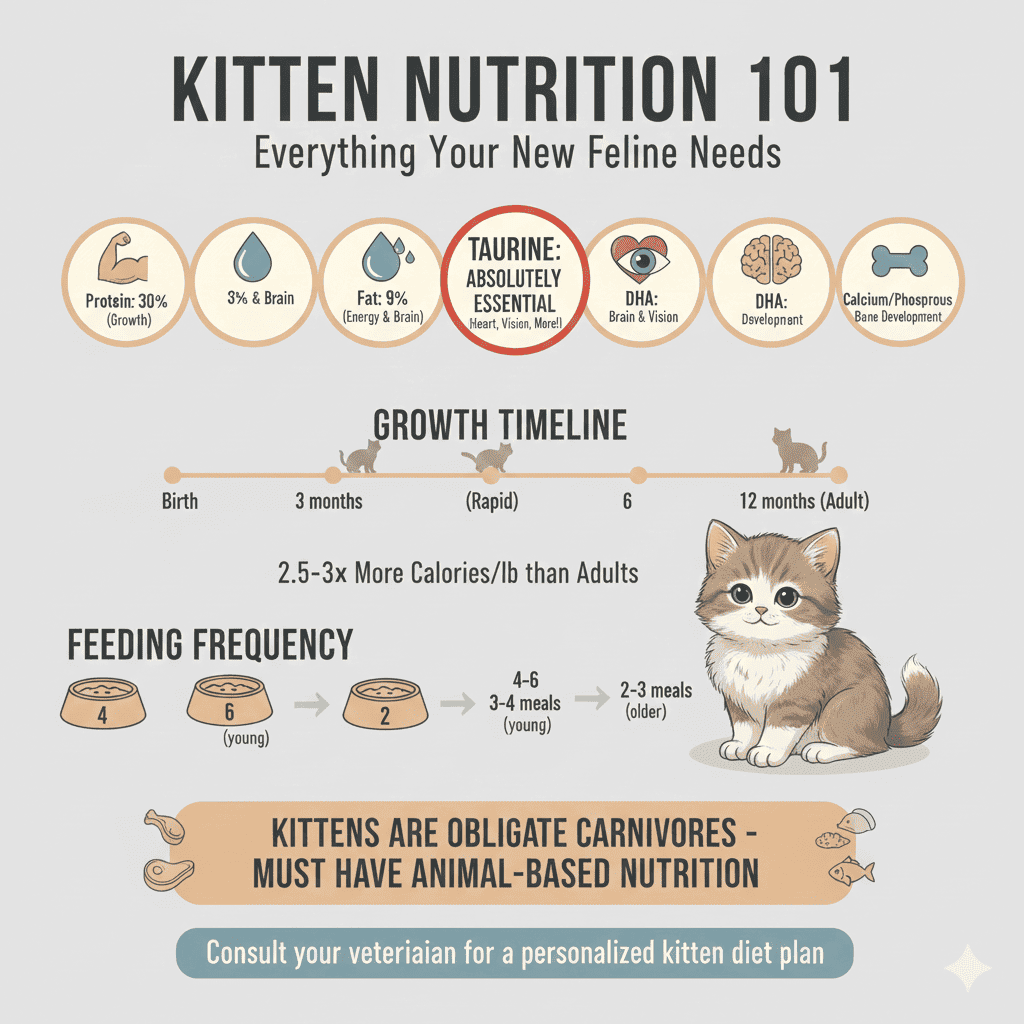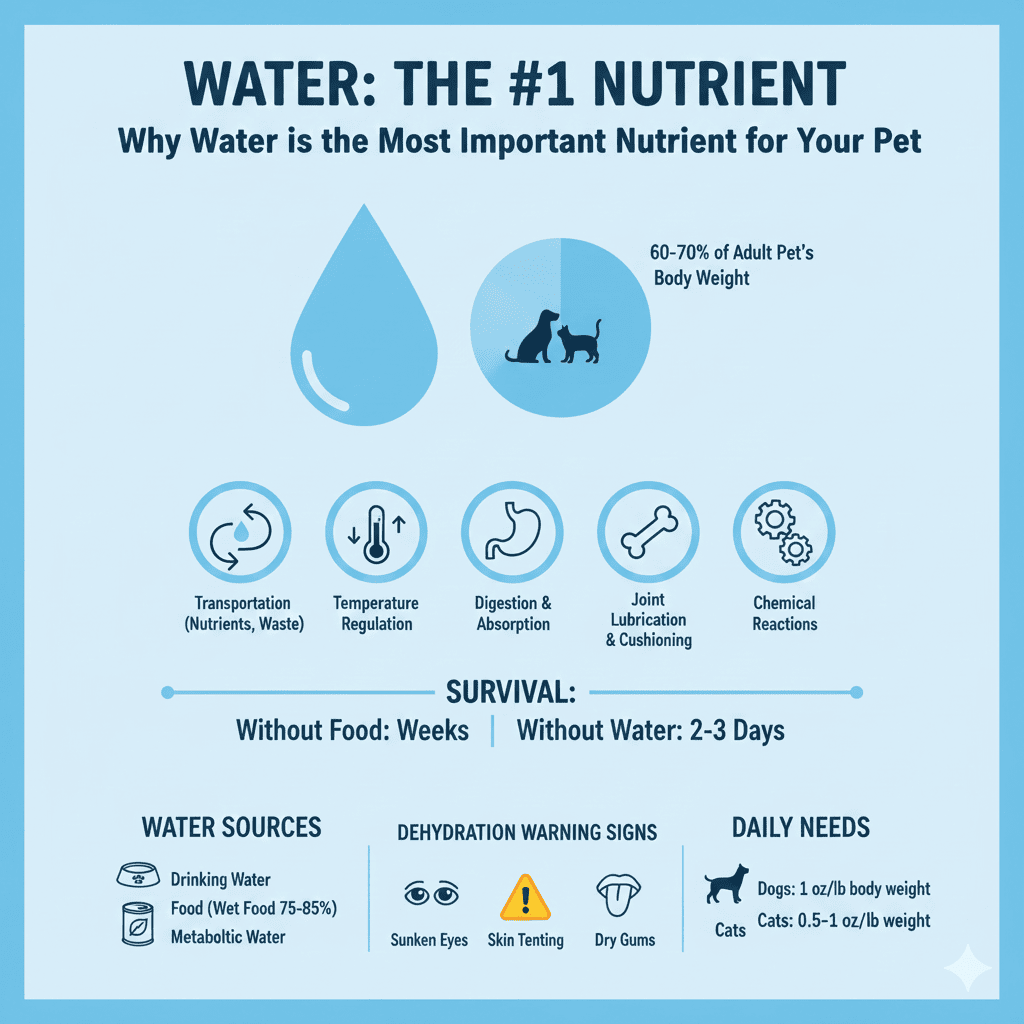Your puppy is growing at an astonishing rate. In their first year, they'll transform from a tiny, helpless creature into a full-grown dog. This rapid growth requires more than just "puppy food"—it requires understanding the unique nutritional needs of a developing body.
Puppy nutrition is fundamentally different from adult dog nutrition. What works for an adult dog can actually harm a growing puppy. Too much of some nutrients, too little of others, or the wrong balance can affect your puppy's health for their entire life.
Understanding puppy nutrition is one of the most important investments you can make in your dog's future. The foundation you build now will support them for the next 10-15 years.
Why Puppy Nutrition is Different
The Growth Phase
Puppies grow rapidly:
- Most breeds reach 50% of adult weight by 4-6 months
- Small breeds may reach full size by 8-10 months
- Large breeds continue growing until 12-18 months
- Giant breeds may grow until 24 months
This rapid growth requires:
- 2-3 times more calories per pound than adult dogs
- Higher protein for building new tissues
- More calcium and phosphorus for bone development
- Balanced nutrients in precise ratios
- Frequent meals to support constant growth
Critical Development Periods
Bone development:
- Most rapid in first 6 months
- Requires proper calcium/phosphorus ratio
- Too much or too little can cause skeletal problems
Brain development:
- Rapid in first 3 months
- Requires DHA (omega-3 fatty acid)
- Affects learning and behavior
Immune system:
- Developing throughout first year
- Requires adequate protein and antioxidants
- Affects lifelong health
Muscle development:
- Continuous throughout growth
- Requires high-quality protein
- Affects strength and mobility

Key Nutritional Requirements for Puppies
Protein
Minimum requirement:
- 22% protein (dry matter basis) for growth
- Adult dogs need only 18% (for comparison)
- Higher quality protein is essential
Why more protein:
- Building new tissues constantly
- Rapid muscle development
- Organ growth and development
- Immune system development
Quality matters:
- Animal-based proteins preferred
- Complete amino acid profiles essential
- High digestibility crucial
Fat
Minimum requirement:
- 8% fat (dry matter basis) for growth
- Adult dogs need 5% (for comparison)
- Higher levels often beneficial (up to 20-25%)
Why more fat:
- Energy density: Puppies need lots of calories in small amounts
- Essential fatty acids: For brain and vision development
- DHA: Critical for brain development
- Skin and coat health: Developing healthy skin and fur
DHA (Docosahexaenoic acid):
- Omega-3 fatty acid
- Critical for brain and vision development
- Should be in puppy food
- Especially important in first 3 months
Calcium and Phosphorus
Critical balance:
- Calcium: Essential for bone development
- Phosphorus: Works with calcium for bone health
- Ratio is crucial: Should be 1.2:1 to 1.4:1 (calcium to phosphorus)
- Too much or too little: Can cause serious skeletal problems
Common problems:
- Excess calcium: Can cause skeletal abnormalities, especially in large breeds
- Insufficient calcium: Can cause weak bones, fractures
- Wrong ratio: Can cause developmental orthopedic disease
Large breed puppies:
- Need controlled calcium levels
- Should not exceed 1.8% calcium (dry matter)
- Prevents rapid growth that causes joint problems
Calories
High calorie needs:
- 2-3 times more calories per pound than adults
- Varies by breed size and growth rate
- Must support growth without causing obesity
Factors affecting needs:
- Breed size: Small breeds need more per pound
- Growth rate: Faster growers need more
- Activity level: Active puppies need more
- Individual metabolism: Varies by puppy
Breed Size Considerations
Small Breed Puppies (Under 20 lbs adult weight)
Characteristics:
- Reach full size quickly (8-10 months)
- High metabolic rate
- Small stomach capacity
- Need calorie-dense food
Nutritional needs:
- Higher calories per pound than large breeds
- Smaller kibble size for small mouths
- Frequent meals (3-4 times daily)
- High-quality, digestible ingredients
Common issues:
- Hypoglycemia: Low blood sugar from missed meals
- Small stomach: Can't eat large amounts at once
- High energy needs: Need calorie-dense food
Medium Breed Puppies (20-50 lbs adult weight)
Characteristics:
- Moderate growth rate
- Reach full size by 10-12 months
- Balanced nutritional needs
Nutritional needs:
- Standard puppy formulas usually appropriate
- Moderate calorie density
- Regular meal schedule (3 times daily)
- Balanced nutrients
Large Breed Puppies (50-100 lbs adult weight)
Characteristics:
- Slower growth rate (but still rapid)
- Continue growing until 12-18 months
- Prone to skeletal problems if overfed
Nutritional needs:
- Controlled calorie intake (prevent rapid growth)
- Controlled calcium (1.0-1.8% dry matter)
- Large breed puppy formulas recommended
- Slower growth is healthier for joints
Critical considerations:
- Don't overfeed: Rapid growth causes joint problems
- Use large breed formulas: Specifically designed for controlled growth
- Monitor body condition: Keep at ideal weight, not overweight
- Avoid supplements: Don't add extra calcium
Giant Breed Puppies (Over 100 lbs adult weight)
Characteristics:
- Very slow but steady growth
- Continue growing until 18-24 months
- Highest risk of skeletal problems
Nutritional needs:
- Strict calorie control essential
- Controlled calcium (1.0-1.5% dry matter)
- Giant breed formulas essential
- Very slow growth is critical
Critical considerations:
- Must use giant breed formulas
- Monitor growth rate: Should be gradual, not rapid
- Regular veterinary monitoring: Check for skeletal issues
- Avoid overfeeding: Even slight overfeeding can cause problems
Feeding Schedule
Frequency
Very young puppies (6-12 weeks):
- 4 meals per day (every 4-6 hours)
- Small stomachs can't hold much
- Prevents hypoglycemia
- Supports constant growth
Young puppies (3-6 months):
- 3 meals per day
- Still growing rapidly
- Good meal frequency
Older puppies (6-12 months):
- 2-3 meals per day
- Can handle larger meals
- Still growing (especially large breeds)
Transition to adult:
- Gradually reduce to 2 meals per day
- Usually around 12 months (varies by breed)
- Large/giant breeds may stay on puppy food longer
Portion Control
Don't free-feed:
- Puppies may overeat
- Can't monitor intake
- Difficult to adjust portions
- Can cause rapid growth (especially large breeds)
Measure portions:
- Use measuring cups or scale
- Follow feeding guidelines as starting point
- Adjust based on body condition
- Monitor and adjust regularly
Transitioning to Adult Food
When to Transition
Small breeds:
- Usually around 9-12 months
- May transition earlier if fully grown
Medium breeds:
- Usually around 12 months
- When growth slows significantly
Large breeds:
- Usually around 12-18 months
- When growth plateaus
Giant breeds:
- Usually around 18-24 months
- When fully grown
How to Transition
Gradual transition:
- Week 1: 75% puppy food, 25% adult food
- Week 2: 50% puppy food, 50% adult food
- Week 3: 25% puppy food, 75% adult food
- Week 4: 100% adult food
Watch for:
- Digestive upset (slow down if occurs)
- Changes in appetite
- Body condition changes
- Adjust portions as needed
Common Puppy Nutrition Mistakes
Mistake 1: Overfeeding
Problem:
- "Puppies need lots of food to grow"
- Can cause rapid growth, obesity, skeletal problems
Solution:
- Feed appropriate amounts
- Monitor body condition
- Adjust portions regularly
Mistake 2: Using Adult Food
Problem:
- Adult food doesn't meet puppy needs
- Insufficient protein, calories, nutrients
Solution:
- Always use puppy-specific food
- Or "all life stages" food (meets growth standards)
Mistake 3: Adding Supplements
Problem:
- Extra calcium can cause skeletal problems
- Unbalanced nutrition
Solution:
- Use complete puppy food
- Don't add supplements unless veterinarian recommends
Mistake 4: Rapid Food Changes
Problem:
- Switching foods suddenly causes digestive upset
- Stressful for growing puppy
Solution:
- Always transition gradually
- Give digestive system time to adapt
Mistake 5: Ignoring Breed Size
Problem:
- Feeding small breed food to large breed puppy (or vice versa)
- Doesn't meet specific needs
Solution:
- Choose food appropriate for breed size
- Large/giant breeds need special formulas
Monitoring Your Puppy's Growth
Body Condition Score
Check monthly:
- Should maintain BCS 4-5 (ideal)
- Not too thin, not too heavy
- Adjust portions if needed
Signs of problems:
- Too thin: Ribs visible, poor growth
- Too heavy: Can't feel ribs, rapid growth
Growth Rate
Should be steady:
- Not too fast (especially large breeds)
- Not too slow (may indicate problems)
- Regular weight checks
Veterinary Checkups
Regular visits:
- Monitor growth
- Check for skeletal issues
- Adjust nutrition as needed
- Ensure proper development
Special Considerations
Picky Eaters
Common in puppies:
- May be going through phases
- Try different textures (wet, dry, mixed)
- Ensure food is fresh
- Don't encourage pickiness with treats
Food Allergies
Watch for signs:
- Itchy skin
- Digestive upset
- Ear infections
- Consult veterinarian if suspected
Health Issues
Some puppies have special needs:
- Congenital issues
- Digestive problems
- Food sensitivities
- Work with veterinarian for special diets
The Bottom Line
Puppy nutrition is a critical foundation for your dog's lifelong health. The rapid growth phase requires specific nutrients in precise amounts, and getting it right (or wrong) can affect your dog for their entire life.
Key takeaways:
- ✅ Puppies need 2-3 times more calories per pound than adults
- ✅ Higher protein (22% minimum) and fat (8% minimum) required
- ✅ Calcium/phosphorus balance is critical (especially for large breeds)
- ✅ Breed size matters—large/giant breeds need special formulas
- ✅ Feed frequent meals (3-4 times daily for young puppies)
- ✅ Monitor body condition and growth rate regularly
- ✅ Transition to adult food gradually when appropriate
Investing in proper puppy nutrition is investing in your dog's future. Feed them well, monitor their growth, and work with your veterinarian to ensure they develop into healthy, happy adults.
Ready to create a personalized meal plan for your growing puppy? Use our pet meal planner to find puppy-appropriate foods and calculate the right portions for your pup's unique needs.
For more information on transitioning your puppy to adult food, see our article: The Transition from Puppy to Adult Food: When and How.


